Quick facts about toy poodles
Height: Less than 10 inches tall
Weight: 4 - 6 pounds.
Video of the Day
Video of the Day
AKC Breed Group: Non-sporting group
Lifespan: 10 and 18 years.
Coat length: Short but tight and curly
Coloring: White, black, gray, brown, and apricot. Always solid colors
Grooming needs: Grooming needs are high including regular clipping
Friendliness: Very friendly and good family dogs, but breed alone does not guarantee personality
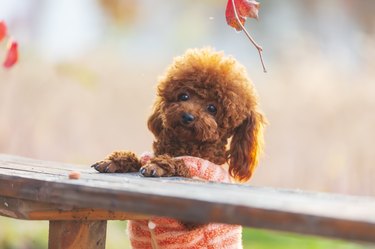
Toy Poodle Dog Breed Information & Care
Toy poodles are small dogs and therefore extremely cute and easy to carry. However, toy poodles are smart and energetic, requiring a reasonable amount of exercise though not a lot of space. Also, toy poodles are ideal for families with older kids, couples, and single people willing to give a dog a lot of attention and even take them along on trips and errands.
Toy poodle dog breed history
While the poodle dog breed dates to 17th century Germany where they were used as water dogs to retrieve waterfowl from streams and rivers, the toy poodle is a much newer breed. The toy poodle was introduced to the US in the early 20th century after the popularity of the miniature poodle led to even smaller dogs which were considered to be ideal for city living.
The toy was originally created by breeding the smallest versions of miniature poodles together and has been a recognized American Kennel Club (AKC) breed since 1887. The Poodle Club of America was formed in 1931.
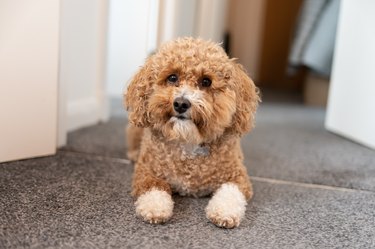
Toy poodle dog breed characteristics
Toy poodles are small dogs, so require a smaller but safe environment where they will not be injured. Generally, friendly, active, and loyal, toy poodles are easy to train but tend to be barkers. Like poodles of all sizes, toy poodles need regular grooming and brushing but are considered low on the allergy-inducing scale.
What is the difference between a toy poodle and a miniature poodle?
The primary difference between a toy poodle and a miniature poodle is size. Yes, a miniature poodle is, as the name implies, smaller than a standard poodle. Miniature poodles are generally 10 to 15 inches tall and weigh between 10 and 15 pounds making them mid-sized poodles.
If a poodle is smaller than these dimensions, they are considered a toy, especially in the show ring. Both toy and miniature poodles were genetically selected by breeders to be a small size. Sometimes people refer to toy poodles as the teacup poodle.

Toy poodle temperament & training
Despite being small, toy poodles are confident and intelligent dogs, generally easy to train. They have higher-than-average energy levels but are usually eager to please, so they respond well to positive obedience training strategies. Generally, toy poodles are sociable and friendly dogs — very playful and receptive to strangers.
Is there a standard poodle?
Yes, the standard poodle is as its name suggests the standard (or original) size of the poodle dog breed. Standard poodles are much larger than either miniature or toy poodles, standing more than 15 inches tall and weighing between 40 to 70 pounds depending on sex.
Despite being the national dog of France, the standard poodle actually evolved as a retrieving water dog in Germany more than four centuries ago. Other than size, there is no difference between the three AKC-recognized breeds of poodles.
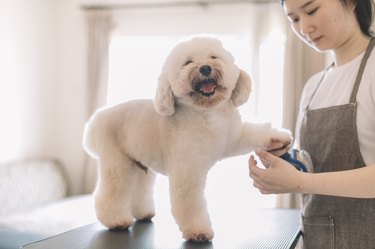
Grooming a toy poodle
While the toy poodle might require shorter walks than other dog breeds, its grooming needs are high. A poodle's coat should be brushed every other day and requires regular clipping and scissoring, best left to professional groomers. Failure to groom frequently results in the fur growing, rather than shedding, and likely cording and matting.
Like all poodle breeds, the toy poodle has a specific show cut with characteristic pompons left on the ankles and back, while other areas are shaved smooth. This look, called the Continental clip, served practical purposes when poodles were retrieving dogs — the comical tufts of fur kept key organs and joints warm in cold water. However, most pet poodles today are given a more practical cut that leaves the coat evenly clipped all over the body.
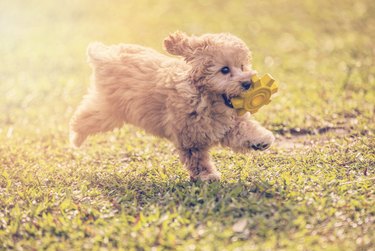
Toy poodle exercise & health
Toy poodles can be energetic. Although they look like they'd make quiet lap dogs (Maltese were actually bred for that purpose), toy poodles require activities and mental stimulation. They do well in athletic competitions such as low jump agility classes. Regular walking is required, but about an hour per day usually suffices to fulfill their exercise needs.
Because they are small dogs, toy poodles generally have long lifespans, up to 18 years, but can suffer breed-specific health problems. Toy poodle health issues include the following:
- hip dysplasia
- eye disorders
- Von Willebrand's Disease
- Idiopathic epilepsy
- legg-calvé-perthes
- progressive retinal atrophy (PRA)
Notably, leg problems such as luxating patellas, are more likely in the small breeds of poodles than the standard poodle.
Can toy poodles be left alone?
Like most dogs, toy poodles should not be left alone for very long. When people ask this question, they often mean do toy poodles suffer from separation anxiety? The answer is usually yes, because toy poodles are very loyal dogs. Generally, they should not be left alone longer than nine hours at a time.
Raising a toy poodle puppy
Fully-grown toy poodles are small and adorable, so imagine the appeal of a toy poodle puppy. Although most poodles make great family pets, the toy poodle specifically is not recommended for small children, because it is a delicate dog easily injured if knocked, stepped on, or dropped. They are not robust dogs.
Toy poodles are fully grown at one year old. During their first puppy year, they should start to get wet food at about four weeks old, have teeth coming in at six weeks, and be weaned at eight weeks. By 12 weeks old they are ready to leave the litter, and at around 17 weeks old, they should experience their first groom.
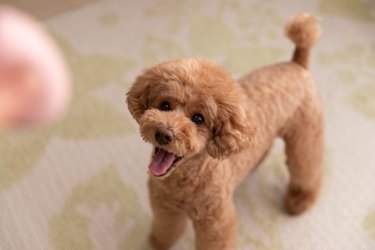
How big does a toy poodle get?
By definition, toy poodles are small — no bigger than 10 inches tall and no heavier than 6 pounds. According to breed standards for show dogs, if a poodle exceeds this size, they are considered a miniature, not toy, poodle. Unless you are planning to participate in dog shows, however, this distinction shouldn't impact a family pet.
However, because of their size criteria, toy poodles make great traveling companions, particularly for those planning to fly often for longer trips. Toy poodles fit easily into standard-sized airplane pet carry-ons, so can be brought into the flight cabin with you if the airline permits pets on board. This is significantly preferable to flying your best friend in the cargo hold.
What are the pros and cons of a toy poodle?
Clearly, the first benefit of the toy poodle breed is portability. Toy poodles can fit into a pet carry-on bag if you are flying, and they never exceed the weight maximum at dog-friendly hotels. Also, they can be easily carried "hand-bag" style when you are out and about in crowded places. Otherwise, they walk quickly on their own.
The toy poodle's curly tight fur is considered a low-allergen coat (no dog breed is entirely hypoallergenic), Therefore, poodles and poodle mixes are generally considered good for people with mild pet allergies. Also, the diminutive toy poodle specifically makes a desirable apartment or condo pet because they require less space.
However, toy poodles require attention and tend to be more vocal than other dog breeds. Leaving them alone for long periods might not make you popular with neighbors. Also, poodles do not shed and require regular grooming. Either plan for that expense or be prepared to learn how to use dog clippers yourself. Because these little dogs are delicate, they are not recommended for families with very young children.